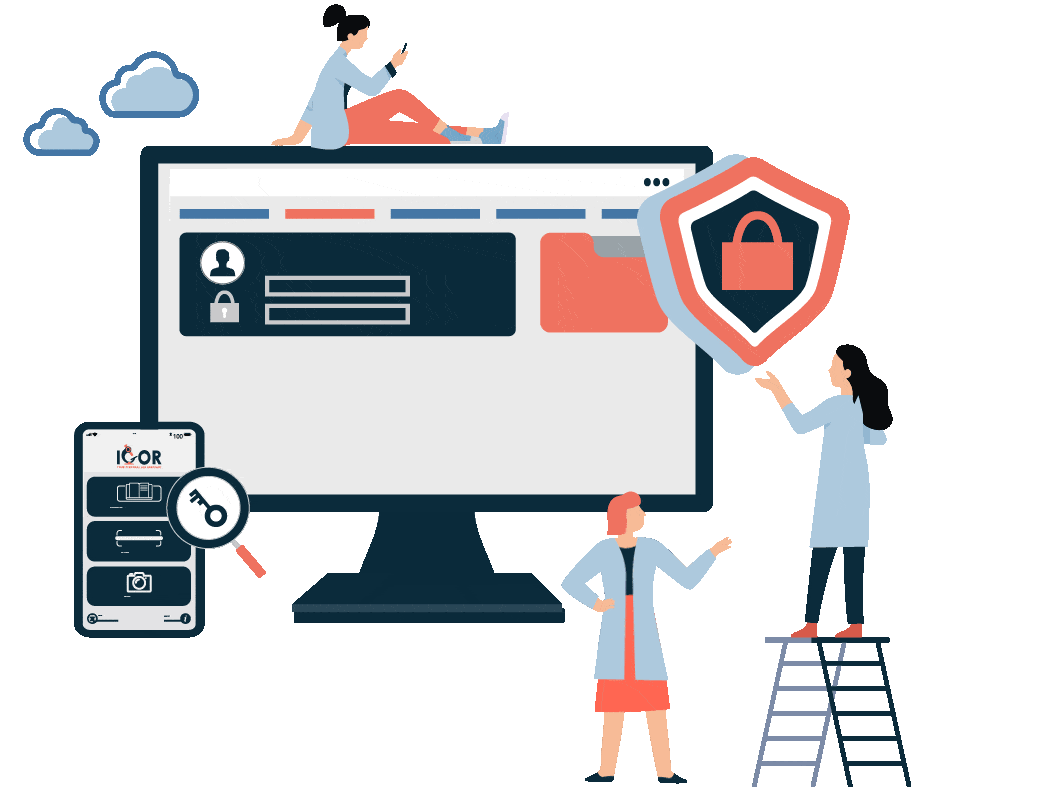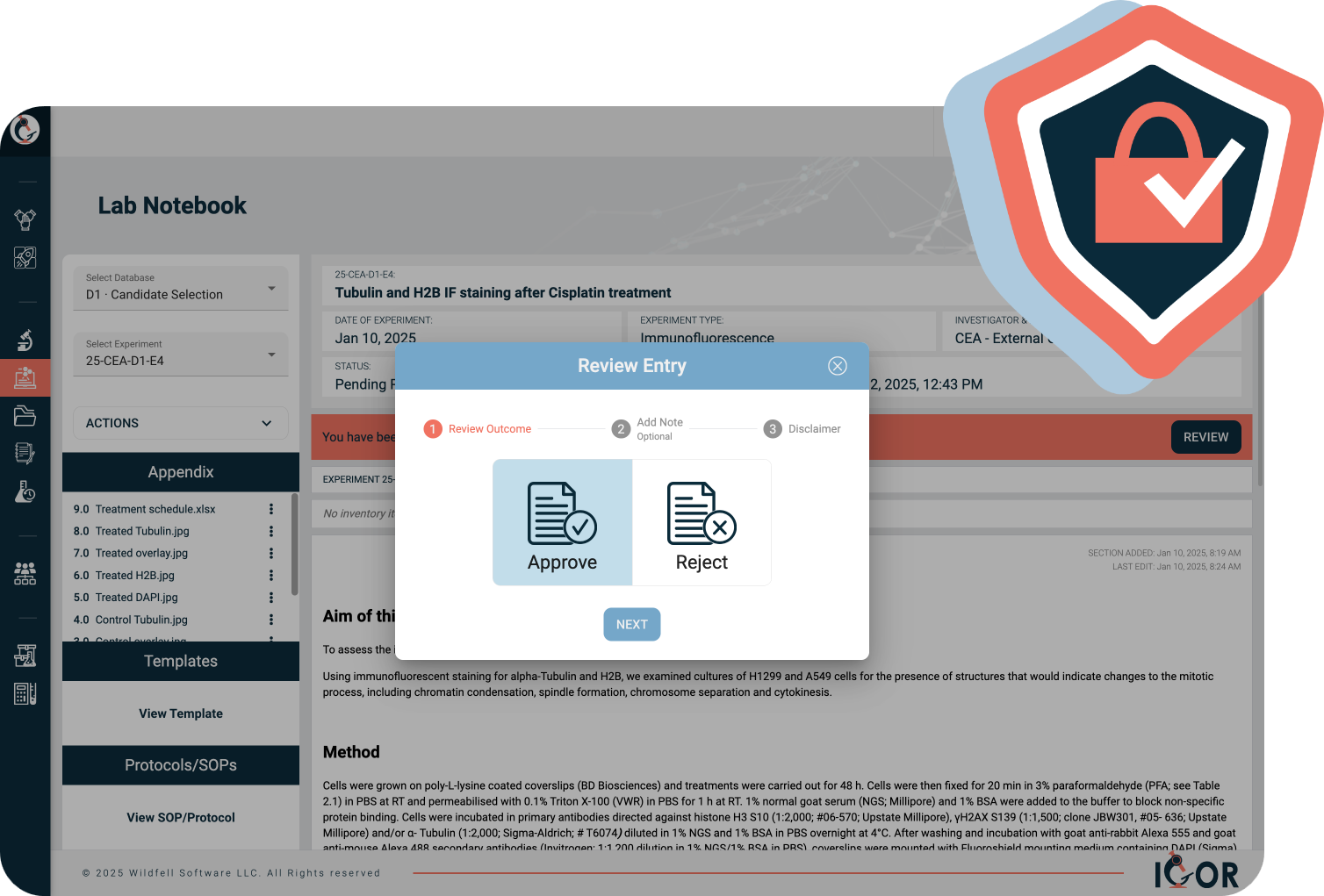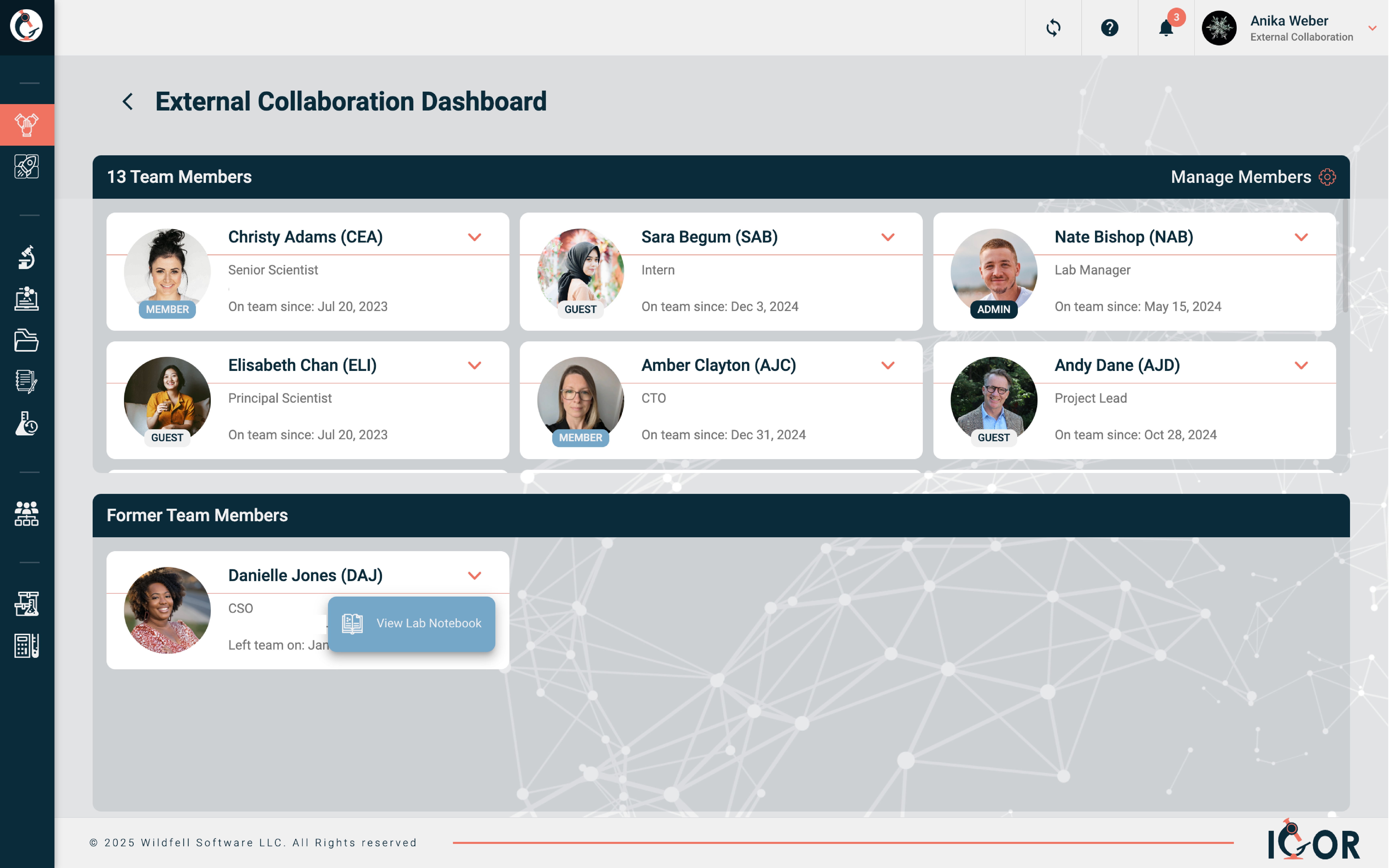IGOR ensures your research data stays organized, secure, and easily accessible - facilitating collaboration and boosting productivity across your team.
IGOR’s Electronic Lab Notebook (ELN) centralizes notes, results, files, and SOPs in one searchable workspace. Use templates and required fields to standardize entries, add metadata for powerful filters, and link samples and reagents for full context.
Built-in version history, permissions, and e-signatures keep records compliant, audit-ready, and easy to share.
That means reliable documentation, end-to-end traceability, and faster reviews - so your team can make important research decisions with confidence.






Why separate your lab inventory from the rest of your research workflow?
IGOR’s electronic lab notebook integrates seamlessly with its advanced lab inventory management system, creating a direct connection between your experiments and your lab’s inventory. This makes it simple to link samples, reagents, and other materials directly to your notebook entries.
From one place, you can trace how your samples and reagents are used, follow their relationships across experiments, and check what’s in stock. Every material’s history is right there when you need it.
Scientific ideas move quickly. Your documentation should keep up. IGOR’s ELN is designed to save researchers hours every week by making experiment tracking simple, searchable, and reproducible. No more lost details, scattered files, or chasing down the latest version - everything is structured, linked, and accessible in one place.


IGOR brings transparency and control to your research data management. Every edit, update, or revision of your lab notebook entries is automatically logged with secure, tamper-proof timestamps, providing a detailed version history that you can trust.
Mistakes happen - but with IGOR, they don’t have to slow you down. Whether you’ve accidentally deleted a file or overwritten important details, you can quickly view, restore, or audit previous versions of notebook entries, templates, protocols, or data files.
With IGOR’s advanced role- and permission-based access controls, team admins can customize access levels to fit the needs of your lab.
Whether it’s allowing or restricting access to research data, associated files, inventory repositories, or essential team SOPs and templates, you can ensure that each team member has the appropriate permissions for their role. This adaptable system safeguards sensitive data while allowing your team to work confidently and securely within their designated responsibilities.


With IGOR’s robust digital signature workflows, quality assurance becomes a seamless part of your research process. Team members can easily review and witness each other’s work, adding their 21 CFR Part 11-compliant digital signatures to confirm accuracy and compliance. Each signature is accompanied by the witness's name, a secure timestamp, and any additional notes to the author, creating a comprehensive audit trail that supports traceability and accountability.
Once a notebook entry is witnessed, it is locked to prevent further editing, ensuring the integrity of your documentation and meeting strict regulatory requirements.
But what happens if an error is found after an entry is locked? IGOR provides a compliant solution - allowing corrections to be made while preserving the original entry and maintaining a clear, auditable record of all changes. This balance of security and flexibility ensures your lab's workflows remain efficient and trustworthy.


With IGOR’s robust digital signature workflows, quality assurance becomes a seamless part of your research process. Team members can easily review and witness each other’s work, adding their 21 CFR Part 11-compliant digital signatures to confirm accuracy and compliance. Each signature is accompanied by the witness's name, a secure timestamp, and any additional notes to the author, creating a comprehensive audit trail that supports traceability and accountability.
With IGOR, you can export your notebook entries as well-presented PDF reports at any time. Without additional effort, PDF exports of your notebook entries will look professional.
No more ugly floating footnotes or cut-off images!

Upload any file type, import Excel data, add image galleries, and link directly to samples or reagents from your inventory.
Stay audit-ready with built-in version control, digital signatures, and timestamped audit trails.
Find past work in seconds with structured fields, filters, and custom, yet standardized metadata tags for reliable data capture.
Explore how IGOR keeps your research data and materials organized, traceable, and seamlessly connected.
It depends on the ELN you're using, but generally speaking: Yes. Most modern electronic lab notebooks, including IGOR, are cloud-based - which means you can securely access your data from anywhere with an internet connection.
Remote access also makes collaboration easier. Team members at different locations can work on the same project, share updates, and review data without emailing files or managing version conflicts.
That depends on the system you’re using. Many electronic lab notebooks either don’t include inventory management at all, or offer a basic version added as an afterthought. These often lack flexibility for customization, or any real connection between your inventory data and experimental records.
IGOR, however, is one of the few ELNs designed with fully integrated inventory management and sample tracking built in from the start. You can link samples, reagents, and consumables directly to experiments, trace how they’re connected or derived from one another, and see the full story of your research, from the materials that went in to the results that came out.
That really depends on the system, and it’s worth asking each vendor to explain their data encryption, backup, and overall security setup in detail.
Most modern ELNs - IGOR included - are hosted on secure cloud infrastructure such as Amazon Web Services (AWS). AWS is widely used across healthcare, biotech, and other regulated industries, and provides multiple layers of protection including network monitoring, intrusion detection, and redundancy across geographically distributed data centers.
By building on this foundation, ELN providers can take advantage of AWS’s industry-leading security features - such as strong encryption in transit and at rest, automated backups, geographic redundancy, and role-based access controls - to help protect research data from unauthorized access or loss.
Compared to traditional on-premise setups that rely on local servers and manual backups, a cloud-based system typically offers greater resilience and reliability. Backups and monitoring run automatically, disaster recovery systems are built in, and the infrastructure scales easily as your lab’s data grows - without the need to buy or maintain new hardware.
Customization varies widely between ELN systems, and it’s one of the most important - and most overlooked - areas to evaluate when choosing a platform.
Some ELNs have limited or no customization options at all, while others require vendor support or coding knowledge for even minor adjustments - which can quickly add considerable additional costs.
Limited flexibility can also create adoption problems. When scientists can’t adapt the system to match their actual workflows, frustration grows, and usage drops. The issue is especially common in ELNs that force all teams within an organization to work in a single shared workspace. Even with customization options, that approach rarely works well in larger or multi-department companies, where each group - or client project - has its own needs. The result is often an overly complex system that’s hard to use and requires dedicated staff to maintain.
As scientists, we’ve dealt with many of these same challenges ourselves, so avoiding them became a guiding principle when we designed IGOR. Each team can organize its workspace however it makes sense - quickly, independently, and without coding, vendor support, or extra fees.
As you compare ELN systems, ask vendors specific questions:
- Which parts of the system are customizable?
- How easy is it to customize and maintain?
- Can scientists make changes themselves, or is vendor support required?
- Are customizations included, or do they come at an additional cost?
Getting clear answers to those questions upfront can save your team time, frustration, and significant expense down the road.
When it comes to research documentation, standardization is key.
Scientists within a research team often come from different backgrounds, have varying levels of experience, and naturally develop their own naming conventions or “systems” for organizing data. This almost always causes problems down the line - especially when, years later, someone is trying to piece together what was done and how to reproduce or build on an earlier experiment.
That’s why it’s important to use clear experiment titles, standardized naming conventions, and consistent metadata or tags so entries can be easily searched over time. Most ELN systems, however, rely on each organization to define and enforce its own documentation standards - without them, even a good ELN can become increasingly messy and inconsistent over time.
That's why IGOR, while flexible enough to support extensive customization, was also built on a framework that helps teams establish standardized structure from the start. You can define how experiments are organized and specify the key metadata categories your team should track for each experiment or sample type. IGOR then automatically enforces those standards across your team, ensuring consistent data entry and well-structured records - without being rigid or restrictive.
For the sake of consistency and efficiency, it’s also good practice to create standardized experiment templates and share them across your team. This ensures that everyone captures the same key information for each assay type, making documentation more uniform and saving time in the long run.
It’s also good practice to keep everything that belongs to an experiment together. Link SOPs, data files, reagents, and samples and attach raw data, figures, and analysis outputs directly to the experiment. That way, all experimental context stays organized and easy to find.
Finally, set clear expectations across your team for how entries should be created, reviewed, and finalized. A consistent approach to documentation ensures that everyone can follow the workflow and easily find what they need - even years later.
Yes, digital lab notebooks are already widely used in both academic and industrial research, though often for slightly different reasons.
In academic settings, an ELN helps standardize how data and experiments are documented across teams with varying levels of experience and training. It keeps research organized and consistent, even as students graduate, postdocs move on, or projects change hands - making it much easier to maintain research continuity and traceability over time.
In industry, ELNs serve many of the same purposes but with added focus on data integrity, IP protection, security, and compliance. Features like audit trails, document versioning, user permissions, and electronic signatures help meet standards such as GLP and FDA 21 CFR Part 11.
IGOR supports both worlds. It offers the structure and compliance tools required by regulated industries, while remaining flexible, simple, and easy to use for academic research teams.